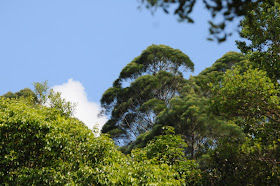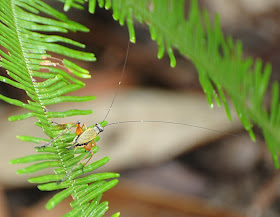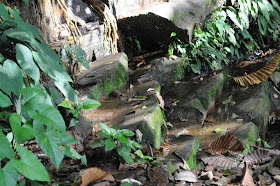On the slopes of Mount Matang, west of Kuching, is the Indian Temple Trail, well-known both as a site for local naturalists and, more significantly, as a trail that once led to a tea plantation owned by Charles Brooke, second of the fabled White Rajahs of Sarawak. With it's combination of ecological and historical interest, it was an ideal place for our friend Lord Cranbrook to take a last nature walk before returning to England.
The road takes its name from this structure, a Hindu temple originally built for Indian workers on the Rajah's plantation. The temple, lost for many years and recently restored, has an interesting history; read about it here.
It is an easy, if uphill, walk into the forest.
The forest parted frequently, revealing the peaks of the Matang massif above us.
Some magnificent trees line the trail.
This splendid tree, called melaban by the iban (Tristaniopsis sp.), shows its typical rainforest form, rising straight and smooth-barked to a great height before throwing off it's first branch - the better to reach the sun without being shaded into darkness by its neighbours, and the better to allow rain to run down its trunk unimpeded. Tristaniopsis can be a dominant tree on rocky slopes in Borneo.
The bark of the melaban (or, in Malay, pelawan) peels away in long strips, like some of the Australian eucalypts -- and indeed this tree belongs to the same family as Eucalyptus, the myrtle family (Myrtaceae). An Iban legend claims that under the strips of bark lies a magical stone, the batu melaban, that will bring its fortunate discoverer perpetual youth. Less romantically, in Brunei its local names (such as selunsur) mean something like "sliding down" - a reference to its peeling bark.
We were a bit late in the day to see much in the way of birdlife, but we did turn up a particularly colourful mammal: Prevost's Squirrel (Callosciurus prevostii). Compare this white-sided animal with the all-dark race pluto I photographed in Sabah only a few days earlier - the Sarawak squirrels are much more attractive (well, I think so).
The paucity of vertebrates didn't mean that there was no animal life to see; on the contrary, there was plenty, but it required Lord Cranbrook and I to get close enough to see it. Eileen remained erect, taking photographs of the (undoubtedly deranged) naturalists.
This is what we were staring at so intently: a column of processional termites (Hospitalotermes) busily crossing the trail. Lord Cranbrook has a family interest in these termites - his nephew, Frederick Gathorne-Hardy, a member of the Termite Research Group at the Natural History Museum in London, studied them in what is now Temburong National Park, Brunei Darussalam, for 65 days in 1991. His report, with a map, was published in Earl of Cranbrook & David S. Edwards, 1994. Belalong: a tropical rainforest (reprinted in softback as A tropical rainforest: the nature of biodiversity at Belalong, Borneo), pp. 234-5 (see also Jones, DT and Gathorne-Hardy, F.(1995).Foraging activity of the processional termite Hospitalitermes hospitalis (Termitidae: Nasutitermitinae) in the rain forest of Brunei, north-west Borneo. Insectes Sociaux 42(4): 359-369).
These are very interesting insects, quite unlike the house-chomping termites we think of in the north. They feed by night, not on wood, but on lichens growing high on the trunks and leaves of canopy trees. This colony is returning to its nest, the workers carrying sprigs of lichen while soldiers, armed with nozzles on their heads capable of spraying noxious chemicals, guarded the column's flanks. While most termites rarely, if ever, emerge into the open, processional termites travel above ground like a stream of ants (which is what I thought they were at first). At dusk (on most nights) they will re-emerge, select a path to follow (no one knows exactly how) and set off, often following the same trail as on earlier visits, to a selected feeding tree.
The road takes its name from this structure, a Hindu temple originally built for Indian workers on the Rajah's plantation. The temple, lost for many years and recently restored, has an interesting history; read about it here.
It is an easy, if uphill, walk into the forest.
The forest parted frequently, revealing the peaks of the Matang massif above us.
Some magnificent trees line the trail.
This splendid tree, called melaban by the iban (Tristaniopsis sp.), shows its typical rainforest form, rising straight and smooth-barked to a great height before throwing off it's first branch - the better to reach the sun without being shaded into darkness by its neighbours, and the better to allow rain to run down its trunk unimpeded. Tristaniopsis can be a dominant tree on rocky slopes in Borneo.
The bark of the melaban (or, in Malay, pelawan) peels away in long strips, like some of the Australian eucalypts -- and indeed this tree belongs to the same family as Eucalyptus, the myrtle family (Myrtaceae). An Iban legend claims that under the strips of bark lies a magical stone, the batu melaban, that will bring its fortunate discoverer perpetual youth. Less romantically, in Brunei its local names (such as selunsur) mean something like "sliding down" - a reference to its peeling bark.
We were a bit late in the day to see much in the way of birdlife, but we did turn up a particularly colourful mammal: Prevost's Squirrel (Callosciurus prevostii). Compare this white-sided animal with the all-dark race pluto I photographed in Sabah only a few days earlier - the Sarawak squirrels are much more attractive (well, I think so).
The paucity of vertebrates didn't mean that there was no animal life to see; on the contrary, there was plenty, but it required Lord Cranbrook and I to get close enough to see it. Eileen remained erect, taking photographs of the (undoubtedly deranged) naturalists.
This is what we were staring at so intently: a column of processional termites (Hospitalotermes) busily crossing the trail. Lord Cranbrook has a family interest in these termites - his nephew, Frederick Gathorne-Hardy, a member of the Termite Research Group at the Natural History Museum in London, studied them in what is now Temburong National Park, Brunei Darussalam, for 65 days in 1991. His report, with a map, was published in Earl of Cranbrook & David S. Edwards, 1994. Belalong: a tropical rainforest (reprinted in softback as A tropical rainforest: the nature of biodiversity at Belalong, Borneo), pp. 234-5 (see also Jones, DT and Gathorne-Hardy, F.(1995).Foraging activity of the processional termite Hospitalitermes hospitalis (Termitidae: Nasutitermitinae) in the rain forest of Brunei, north-west Borneo. Insectes Sociaux 42(4): 359-369).
These are very interesting insects, quite unlike the house-chomping termites we think of in the north. They feed by night, not on wood, but on lichens growing high on the trunks and leaves of canopy trees. This colony is returning to its nest, the workers carrying sprigs of lichen while soldiers, armed with nozzles on their heads capable of spraying noxious chemicals, guarded the column's flanks. While most termites rarely, if ever, emerge into the open, processional termites travel above ground like a stream of ants (which is what I thought they were at first). At dusk (on most nights) they will re-emerge, select a path to follow (no one knows exactly how) and set off, often following the same trail as on earlier visits, to a selected feeding tree.
High earthen banks along the road edge meant that we didn't have to get on our hands and knees for every invertebrate we came across. Here Eileen scours the bankside...
...while Lord Cranbrook gets on close terms with some bankside life...
Including a minute wasp's nest, a beautiful little structure.
This attractive cricket has a particularly long set of antennae… [update: a Common Bush Cricket (Nisitrus sp)]
...but for long appendages this crab spider (presumably in the genus Gasteracantha) is hard to beat. [update: Gasteracantha arcuata]
Spiders were particularly obvious during our walk. Giant orb spiders in the genus Nephila waited for prey in the hubs of their enormous webs. The spider in the upper photo seems to be reeling in a meal.
This extraordinary jumping spider looks more like a miniature land crab.
Some people prefer butterflies to spiders; I have no idea why... Anyway, this is (I think) a female Blue Count (Tanaecia clathrata).
These two photographs should give you an idea of the diversity in the genus Begonia, at least in leaf shape.
These two photographs should give you an idea of the diversity in the genus Begonia, at least in leaf shape.
Here is a brace of ferns; the last of them doesn't look terribly fernlike to temperate-trained eyes, but it is a perfectly good fern all the same: specifically, a red finger fern or paku jari merah (Lygodium circinnatum).
I am always fascinated by the range of leaf shapes in tropical forests!
Our path was enlivened by a number of dragonflies. This one, with the dark areas of its wings extending almost to their tips, is probably Neurothemis terminata. Neurothemis dragonflies, with their distinctively-patterned wings, are common in Borneo, even in roadside ditches.
This is probably a male Orthetrum glaucum.
This looks very much like the last, but it seems to have quite a bit more pruinosity (the dusty covering that gives it that particular shade of blue) and to be lacking the dark patch at the base of the hindwing that is typical of Orthetrum glaucum. There are a number of other pruinose blue libellulid dragonflies on Borneo; which one is this? Perhaps Brachydiplax farinosa, though that species seems usually to have the last third of the abdomen dark? Anyone?
Female dragonflies usually defeat my attempts at identification, Rspecially since I make most of these attempts after the fact based on whatever my photographs show. This may, however, be a female Orthetrum.
These are not dragonflies but damselflies.probably one of the six very similar species in the genus Vestalis (Calopterygidae). Apparently you need a microscope to tell the species apart with certainty.
These half-hidden steps are a reminder of the presence, of that remarkable man Charles Brooke, the Second Rajah of Sarawak and the man who built the state into a modern society. They give the trail an extra touch of human history lying behind the encroachments of nature.
I am always fascinated by the range of leaf shapes in tropical forests!
Our path was enlivened by a number of dragonflies. This one, with the dark areas of its wings extending almost to their tips, is probably Neurothemis terminata. Neurothemis dragonflies, with their distinctively-patterned wings, are common in Borneo, even in roadside ditches.
This is probably a male Orthetrum glaucum.
This looks very much like the last, but it seems to have quite a bit more pruinosity (the dusty covering that gives it that particular shade of blue) and to be lacking the dark patch at the base of the hindwing that is typical of Orthetrum glaucum. There are a number of other pruinose blue libellulid dragonflies on Borneo; which one is this? Perhaps Brachydiplax farinosa, though that species seems usually to have the last third of the abdomen dark? Anyone?
Female dragonflies usually defeat my attempts at identification, Rspecially since I make most of these attempts after the fact based on whatever my photographs show. This may, however, be a female Orthetrum.
These are not dragonflies but damselflies.probably one of the six very similar species in the genus Vestalis (Calopterygidae). Apparently you need a microscope to tell the species apart with certainty.
These half-hidden steps are a reminder of the presence, of that remarkable man Charles Brooke, the Second Rajah of Sarawak and the man who built the state into a modern society. They give the trail an extra touch of human history lying behind the encroachments of nature.





































Good to hear that you have great times at Mount Matang. Thanks for exposing Borneo wildlife.
ReplyDelete-
RWS, Kuching